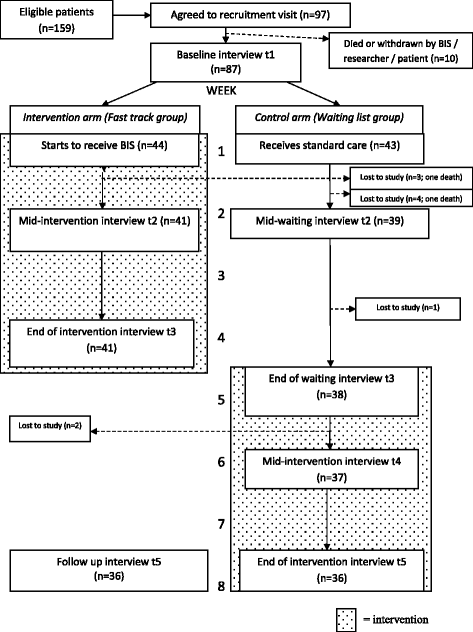The clinical and cost effectiveness of a Breathlessness Intervention Service for patients with advanced non-malignant disease and their informal carers: mixed findings of a mixed method randomised controlled trial
- PMID: 27044249
- PMCID: PMC4820876
- DOI: 10.1186/s13063-016-1304-6
The clinical and cost effectiveness of a Breathlessness Intervention Service for patients with advanced non-malignant disease and their informal carers: mixed findings of a mixed method randomised controlled trial
Abstract
Background: Breathlessness is the most common and intrusive symptom of advanced non-malignant respiratory and cardiac conditions. The Breathlessness Intervention Service (BIS) is a multi-disciplinary complex intervention, theoretically underpinned by a palliative care approach, utilising evidence-based non-pharmacological and pharmacological interventions to support patients with advanced disease in managing their breathlessness. Having published the effectiveness and cost effectiveness of BIS for patients with advanced cancer and their carers, we sought to establish its effectiveness, and cost effectiveness, in advanced non-malignant conditions.
Methods: This was a single-centre Phase III fast-track single-blind mixed method RCT of BIS versus standard care for breathless patients with non-malignant conditions and their carers. Randomisation was to one of two groups (randomly permuted blocks). Eighty-seven patients referred to BIS were randomised (intervention arm n = 44; control arm n = 43 received BIS after four-week wait); 79 (91 %) completed to key outcome measurement. The primary outcome measure was 0-10 numeric rating scale for patient distress due to breathlessness at four weeks. Secondary outcome measures were Chronic Respiratory Questionnaire, Hospital Anxiety and Depression Scale, Client Service Receipt Inventory, EQ-5D and topic-guided interviews.
Results: Qualitative analyses showed the positive impact of BIS on patients with non-malignant conditions and their carers; quantitative analyses showed a non-significant greater reduction in the primary outcome ('distress due to breathlessness'), when compared to standard care, of -0.24 (95 % CI: -1.30, 0.82). BIS resulted in extra mean costs of £799, reducing to £100 when outliers were excluded; neither difference was statistically significant. The quantitative findings contrasted with those previously reported for patients with cancer and their carers, which showed BIS to be both clinically and cost effective. For patients with non-malignant conditions there was a notable trend of improvement over both trial arms to the key measurement point; participants may have experienced a therapeutic effect from the research interviews, diluting the intervention's impact.
Conclusions: BIS had a statistically non-significant effect for patients with non-malignant conditions, and slightly increased service costs, but had a qualitatively positive impact consistent with findings for advanced cancer. Trials of palliative care interventions should consider multiple, mixed method, primary outcomes and ensure that protocols limit potential contaminating therapeutic effects in study designs.
Trial registration: Current Controlled Trials ISRCTN04119516 (December 2008); ClinicalTrials.gov NCT00678405 (May 2008).
Keywords: Advanced disease; Breathlessness; Chronic obstructive pulmonary disease; Complex intervention; Mixed methods; Non-malignant disease; Palliative care; Randomised controlled trial.
References
-
- Gysels M, Bausewein C, Higginson IJ. Experiences of breathlessness: a systematic review of the qualitative literature. Palliat Supp Care. 2007;5:281–302. - PubMed
Publication types
MeSH terms
Associated data
Grants and funding
LinkOut - more resources
Full Text Sources
Other Literature Sources
Medical
Miscellaneous


